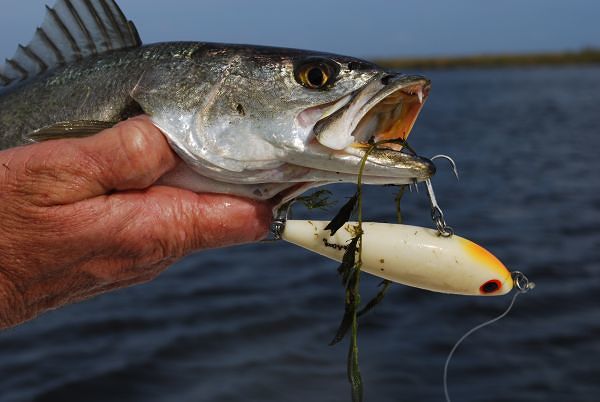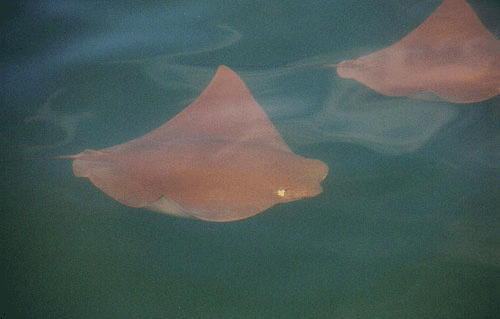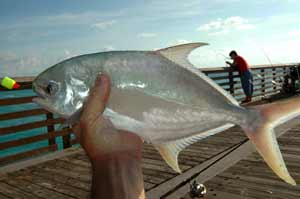Speckled Sea Trout (Cynoscion nebulosus), also known as Spotted Sea Trout, and Sea Trout are an incredibly popular sport fish. Averaging around 1-2lbs but with “Gators” over 15 pounds, Trout can be one of the most fun, and most aggressive fish that can be caught from Florida’s shores.
Where to Find Sea Trout
A voracious predator, Speckled Sea Trout can be found almost anywhere that will hold bait fish or live shrimp. The two most successful places to find them is on the flats near grass beds and at lit docks, bridges and piers at night. While those are the best places to find them, they can also be found in the following areas:
- Inlets
- Creek Mouths
- Oyster Bars
- Drop Offs and Sand Bars
- Bays
- Mangrove Canals
- Almost anywhere that holds bait
Gear
With the average Sea Trout weighing only about 1-2 pounds, in most cases there is no reason to use heavy tackle. Even the largest trout, while they are a fun fight, are not a big challange for any gear that is rated for saltwater. Most Trout anglers will use a spinning reel that is rated for 10lb test line with a medium light action rod. 10lb braid with a 12lb flourocarbon leader will work for even the largest fish (as long as they are not in HEAVY cover). Here are a few gear recomendations:
Reels
The most popular reels to use are spinning reels that are rated for saltwater. While size ratings change from manufacture to manufacture, in general 2000-3000 size spinning reels work the best for Trout. Some recommended reels include:
- Penn Battle Spinning Reel
- Shimano Stradic FJ Spinning Reel
Rods
Trout are exciting, but not very strong fighters, so medium light actions rods work the best for them. They will give the angler the sensitivity needed to detect even the most subtle strikes and enough strength to fight the larger fish. A length of 7 foot or longer will help increase casting distance to help cover more water. When choosing a rod make sure that it is saltwater rated.
Line
Long casts are often required to reach Trout hiding spots so braid is the best line to use, but there are also a few other good reasons to use it. Braid is far more sensitive than any other style of line allowing subtle hits from trout (or other fish) to be detected. Its small diameter allows the bait or lure to reach the strike zone faster and stay there with little resistance. Braid also has higher abrasion resistance which will often come in handy when fishing around structure such as pylons of lit docks and piers. 8-10lb test braid will do fine for most fishing conditions.
For a leader, 10-12lb fluorocarbon line works the best. It is nearly invisible in the water and and has much higher abrasion resistance than monofilament.
Live Bait
Trout are voracious predators and will devour most popular live bait, however there are a few the perform better than others. Here are a few:
- Finger Mullet
- Small Pinfish
- Live Shrimp
- Scaled Sardines
When using live bait the most successful technique is to free-line the bait in areas that trout are known to hold. Using a 1-2/0 circle hook cast just up current of the target and allow the current to drift the bait through the strike zone. Make sure to keep most of the slack out of the line to aid in hook set as well as strike detection. If there is no current simply cast beyond the target and gently reel the bait back trough the strike zone.
If the cast and retrieve method is not working, try soaking live bait in with just enough weight (an egg sinker above a swivel works best) to hold the bottom in the area of interest.
Trout will often be aggressive strikers and the strikes are easy to detect. But on cooler nights or very hot days they have been known to have subtle strikes. Keep an eye on your line and if the movement of the line changes or stops completely reel in all slack and feel for pressure. If there is pressure, set the hook (when using a circle hook, reel in rapidly while gently raising your rod tip, do not jerk as it will pull the hook).
Lures
Trout are one of the most exciting fish to catch on artificial baits. They are willing strikers on almost all popular saltwater lures and they are legendary for their aggressive early morning attacks on top water lures. Some of the more popular lures for Sea Trout are:
- Zara Spook (top water)
- Berkeley Alive Gulp Swimming Mullet
- Soft Jerk Baits
- Soft Paddle Tails
- Hard Plastic Plugs
Early morning offers exciting top-water action, while night time often has great results with diving plugs and soft plastics around well lit docks. When using artificial, in any location, make sure to use a steady but erratic retrieve. Causing a lure to resemble and injured bait fish will trigger the trouts natural predatory instinct and lead to more strikes than a steady strait retrieve.
Tips and Tricks
- Trout are often visible. Look for their flashy silver sides to reflect the sun or lights when they are swimming near the surface.
- Trout have different regulations for different parts of the state, be sure to check your local regulations before harvesting trout.
- Larger Sea Trout have been known to have worms, and they are the breeders, a healthy release is suggested.
- Trout have a sensitive slime coating, if a release is planned handle their skin as little as possible and when touching it, make sure your had is wet first.
- Trout shake their heads pretty violently when hooked, make sure to not allow slack in the line as that will often lead to a pulled hook.
Helpful Links



